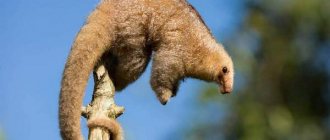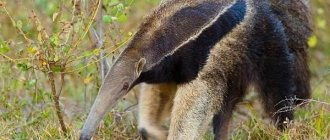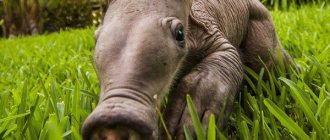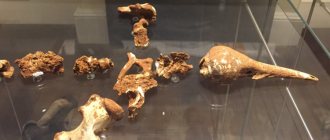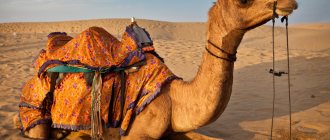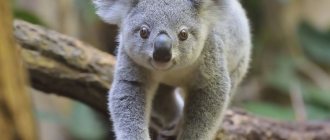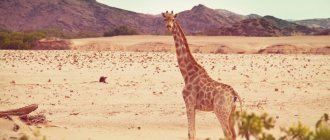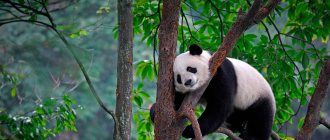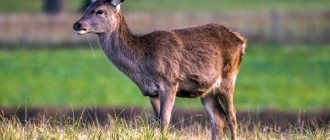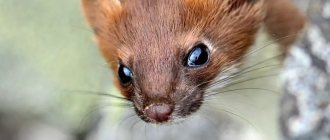- Wild animals
- >>
- Mammals
There are many amazing creatures on our planet, the anteater is perhaps one of them. After all, his extraordinary appearance is very memorable. He is like an alien who came down from a spaceship or an unusual superhero from the pages of colorful comic books. Even Salvador Dali himself was so inspired by the anteater that he decided to be one of the first to have such an exotic pet, which delighted and amazed everyone around him.
Origin of the species and description
Photo: Anteater
From any encyclopedia about animals you can find out that the anteater family includes mammals from the order of edentates. As a result of paleontological excavations in South America, scientists were able to discover the remains of these animals, which they attributed to the Miocene period. However, zoologists suggest that anteaters are much more ancient and appeared much earlier.
From this amazing family, scientists distinguish three genera:
- Giant (large) anteaters;
- Four-toed anteaters or tamanduas;
- Pygmy anteaters.
Varieties of anteaters belonging to different genera differ significantly not only in appearance, habitat, but also in their way of life. Let's take a closer look at each type.
Video: Anteater
The giant anteater rightfully deserves this name, because it is the largest of its family. The length of its body reaches one and a half meters, and if you add the tail, you get almost all three. It should be noted that his tail is very fluffy and looks rich.
The weight of an adult anteater is about 40 kg. He lives exclusively on earth. He walks, bending his paws in an interesting way so as not to rely on huge claws, but steps on the back of his front legs. The muzzle is very elongated. This is not surprising, because it holds a long sticky tongue about 60 cm long.
The tamandua or four-toed anteater is much smaller than the previous one and has a medium build. The length of its body is from 55 to 90 cm, and its weight is from 4 to 8 kg. It got its name because it has four clawed toes on its front paws. Interestingly, the claws on the forelimbs are long, and the claws on the hind five-toed paws are short.
The tail is long, grasping, with a hairless tip, capable of deftly clinging to branches. This anteater feels great both on the ground and in the crown of trees.
The pygmy anteater also lives up to its name, because this baby rarely exceeds a length of 20 cm and weighs only about four hundred grams. This little one lives exclusively in trees, moving in the lush crown with the help of its long, prehensile tail and front clawed paws.
№5
If you think that there is only one type of anteater, then you are mistaken. There is a family of Anteaters (Myrmecophagidae), which includes 4 species:
- Giant (Myrmecophaga tridactyla), also three-toed and large).
- Dwarf (Cyclopes didactylus), also known as two-toed.
- Four-toed tamandua (Tamandua tetradactyla).
- Mexican tamandua (Tamandua mexicana).
All of these species vary in size. The giant grows up to 2.1 meters in length including the tail. The dwarf grows up to 35 cm in length. Four-toed and Mexican grow up to 1.2 meters in length.
Appearance and features
Photo: Animal anteater
We have already found out that representatives of anteaters from different genera look completely different, but some common features of their appearance, of course, are present. One of them is the presence of a long tongue covered with sticky saliva to make it convenient to eat insects. Another common feature for all is the elongated muzzle, similar to a tube, the mouth is presented in the form of a narrow slit.
The same feature for all is small round ears and small eyes. In addition, anteaters have a peculiar gait, because They place their legs with the back of their paws so that their claws do not rest on the ground.
All representatives of anteaters have a tail. In those that lead an arboreal lifestyle, it is strong and tenacious, and does not have long fur, but in the giant anteater it is large and fluffy.
Among representatives of different genera, the female is always slightly smaller than the male. The front paws of all anteaters are equipped with long, powerful hook claws, with which they defend themselves and climb branches. The hind limbs are not as clawed as the forelimbs; the claws on them are much smaller. Every anteater, regardless of what genus and species it belongs to, has a fur coat. Some have silky short and soft fur, while others have rough, bristly and very long fur.
Anteaters also have different colors. Some have a golden-beige coat, others are dark gray with black elements. The abdomen is usually light gray with whitish or yellowish streaks. The color of four-toed anteaters is somewhat reminiscent of the coloring of a giant panda. On his light body, it looks as if he is wearing a black vest. Another common feature for all anteaters is the great strength of the long bones of the skull. In addition, these amazing creatures have no teeth at all, and their lower jaw is very elongated, thin and rather weak.
Interesting Facts
- When eating, the anteater's tongue moves at a speed of one hundred and sixty times per minute. And at the same time, it can destroy about 30 thousand termites per day.
- When attacked by a panther or jaguar, the anteater lies on its back and begins to actively and randomly swing all four paws. Since its paws have quite sharp and powerful claws, this type of protection is very effective.
- Anteaters are very peaceful animals with a gentle character. They are easily tamed and get along well with other pets. The only important nuance is the temperature regime. Ants do not like the cold at all. The best temperature for them is over 26 degrees Celsius.
Where does the anteater live?
Photo: Anteater from South America
Various species of anteaters are quite widely distributed throughout Central and South America, living in the following areas:
- Mexico;
- Bolivia;
- Brazil;
- Paraguay;
- Argentina;
- Peru;
- Panama;
- Uruguay.
First of all, anteaters prefer tropical forests, although some also live in open spaces of savannas. They like to be located along the banks of various bodies of water. Judging by the places of their permanent deployment, it is clear that they are heat-loving animals that prefer hot climates.
If we consider the homes of these animals, they differ depending on the lifestyle (terrestrial or arboreal) that the anteater leads. For giant anteaters, these are usually small holes dug in the ground in which they sleep; sometimes they move into a large hole left by another animal. Four-toed representatives of anteaters love hollows in trees, making cozy and comfortable nests in them.
Pygmy anteaters also live in hollows, only small ones, but they can often be seen resting, hanging on a branch, to which they cling tightly with their curved claws on their forelimbs. Tenacious paws with sharp hooked claws hold them securely, so they are not afraid of falling and even sleep in such a suspended position.
Spread range
Geographical distribution
The giant anteater is a neotropical species that lives at low altitudes. It has a wide distribution throughout southern Central America and northern Latin America, from Honduras in the north to Bolivia and northern Argentina in the south. Its geographic range once extended throughout Guatemala, Uruguay, El Salvador, southern Belize and Costa Rica, but the three-toed anteater is now considered extinct in these countries.
Photo: Wikipedia
Habitat
Giant anteaters prefer a variety of habitats, including wetlands, wet and dry forests, savannas and grasslands. For rest, they choose secluded and well-sheltered places. Large anteaters are sometimes found in agricultural and densely populated regions.
- Habitat: tropical
- Terrestrial biomes: wetlands, forests, savannas
What does an anteater eat?
Photo: Anteater animal
It’s not at all difficult to guess what the anteater’s menu consists of, judging by the name of this wonderful animal. Naturally, this is a huge number of ants and termites. Animals do not disdain other kinds of insects, but the main condition is that they be small, because the anteater is completely devoid of teeth. In this regard, animals swallow their food directly whole, and then it is digested in the stomach. In general, the smaller the anteater itself, the smaller insects it consumes as food.
Surprisingly, anteaters are very picky about their food; they certainly know a lot about tasty termites and ants. They do not eat soldier ants and those insects that have chemical protection in their arsenal. Anteaters consume insects in huge quantities. For example, a giant anteater eats up to 30,000 ants and termites per day, and a four-toed anteater eats about 9,000.
Most often, animals do not drink water; they only need the liquid that enters the body with food. But zoological scientists have found that sometimes they eat the fruits of palm trees, extracting moisture and other valuable nutrients from them with the help of large claws.
Anteaters resemble moving vacuum cleaners that roam forests and savannas in search of termite mounds and anthills. Having found it, a real feast begins for the anteater, ending in complete destruction and destruction for the insects, which are literally sucked out of their home. While eating, the anteater's long tongue moves almost at lightning speed, reaching a speed of 160 movements per minute. Insects adhere to it like Velcro, which they can no longer get rid of.
An interesting fact is that the anteater’s stomach is devoid of hydrochloric acid, which helps digest food. It is replaced by formic acid, which enters the body with food. Sometimes anteaters, like birds, swallow sand and small pebbles; they do this in order to help digestion, enhancing it.
In addition, all anteaters have a very low metabolism. Giant anteaters have a body temperature of only 32.7 degrees, the lowest compared to other placental mammals. In the four-toed and dwarf anteaters it is higher, but not much.
Interestingly, domesticated anteaters eat a much more varied diet than their wild relatives. They happily eat all kinds of fruits and vegetables, drink milk, and love cheese, minced meat, and boiled rice. These are the kind of gourmets, but it’s better not to accustom them to sweets, it’s extremely harmful for them.
What to do to prevent ants from getting in
Ants enter an apartment or private house in search of food or shelter from cold and rain. You need to start fighting them by finding a nest. This is where you can find an ant family. The fight against ants should include the following steps:
- pour boiling water over the nest, keeping in mind that the water is unlikely to reach the queen;
- clean your home and treat all surfaces with a disinfectant;
- seal all cracks and cracks in the floor and walls;
- treat the ant paths with anti-ant gel (Combat, Global, FAS, Dohlox), spray a spray near the anthill (Raptor, Raid, Dichlorvos) or place traps in places where parasites accumulate.
The best remedy for domestic ants is hygiene, timely cleaning, and minor repairs (insects often live in floor crevices, adobe walls, and cracks). Do not leave food or bread crumbs on the table. It is better to take out the kitchen bucket regularly to deprive insects of their food supply.
Features of character and lifestyle
Photo: Great anteater
Naturally, different species of anteaters have different lifestyles. For example, giant anteaters lead a terrestrial life, dwarf anteaters lead an arboreal life, and four-toed anteaters combine both. Animals become most active at dusk. By nature, these unusual creatures are loners, with the exception of females with cubs, although fathers participate in raising children for some time.
Very rarely, anteaters form strong family unions; this behavior is an exception for them, but this, nevertheless, takes place. Nature has not endowed anteaters with sensitive hearing and sharp eyesight, but they have an excellent sense of smell, which helps in searching for tasty treats. Another ability of anteaters is the ability to swim, staying on the water very confidently and successfully overcoming large expanses of water.
When it comes to home furnishings, different species have different preferences. Tamanduas prefer large hollows in trees where they make cozy nests. Giant anteaters dig shallow holes in the ground, which they use for rest, which lasts up to 15 hours a day. As a camouflage and blanket at the same time, they cover themselves with their rich tail, like a lush fan. Dwarf representatives of anteaters most often rest, hanging directly on a branch with the help of tenacious front legs, and they wrap their tail around their hind limbs.
Anteaters have their own separate territories where they feed. If there is plenty of food, then such plots are not large at all, but reach an area of half a square kilometer, such spaces are found in Panama. Where there is no great abundance of food, the anteater's area can reach up to 2.5 hectares.
It is interesting that tamandua is active not only at twilight, it can stay awake throughout the day. If nothing threatens the giant anteater, it is in a calm and quiet environment, then it can also be active during the daytime, it all depends on the surrounding area.
In general, anteaters are not aggressive and are quite good-natured; they prefer peaceful coexistence with other species of animals and will never be the first to attack.
Those who have kept an anteater as a pet claim that the animals are quite intellectually developed, they easily learn many commands, delighting their owners. Most often, a tamandua is kept as a pet, although the famous artist Salvador Dali once preferred the giant anteater, walking it through the streets of Paris on a golden leash, which amazed others.
Habitat
The main territory of residence of the anteater is the South American continent and Central America. The main population has spread to Brazil, Argentina, Paraguay and Uruguay. The northern part of the anteater's distribution area is Mexico. These animals are very thermophilic, so they prefer only warm regions. Anteaters mainly live in forests and plains with tall grass.
Social structure and reproduction
Photo: Baby anteater
As already mentioned, anteaters are solitary animals that prefer to live outside of groups. Only for the period of mating and raising offspring do they form a short-lived family union. It is noteworthy that the male helps the female take care of the common child, which undoubtedly makes him a plus. Although there are exceptions among these mysterious animals, very rarely they can form pairs for many years or even a lifetime; apparently, this is true love.
For the tamandua and the giant anteater, wedding season begins in the fall. The duration of pregnancy in various species lasts from three months to six months. In the spring, the parents give birth to their only cub. He already has sharp claws and quickly climbs onto his mother’s back. The father also carries his child on his back, helping the mother with upbringing for some time. For six months, the female treats the baby with her milk, although often the baby lives with its mother for up to one and a half years until it becomes sexually mature.
It is interesting that in a giant anteater the baby is a small copy of its parents, but in a four-fingered anteater it is completely different from them and can be completely black or white.
Anteaters of the dwarf variety usually mate in the spring. The father also helps the miniature mother raise the baby. In all representatives of anteaters, grown-up babies feed not only on breast milk, but also on insects regurgitated by their parents, thus becoming accustomed to adult food.
Anteaters can rightfully be called real long-livers, because on average these extraordinary representatives of the fauna live from 16 to 18 years, and some specimens lived up to 25.
№9
The gestation period for females lasts 190 days. Usually the female gives birth to only one baby, which she will feed with milk for approximately 6 months. During the first year, the mother carries her baby on her back to protect him from predators. After the baby gets off his mother's back, he will remain with his mother for about a year until she becomes pregnant and gives birth to the next baby.
Natural enemies of anteaters
Photo: Anteater
If in the wild conditions such large predators as pumas and jaguars act as enemies for giant and four-toed anteaters, then for dwarf representatives of the anteater family there are much more dangers; they can even be threatened by large birds and boa constrictors.
The large anteater's main weapon is its huge ten-centimeter claws, with which it can tear apart an enemy like sharp hook knives. During a fight, the animal stands on its hind legs and fights its enemy with its front legs; these strong limbs can even crush the enemy. Often, predators, seeing such courage and power, leave and do not contact the large anteater, because they consider it a dangerous and strong opponent, capable of inflicting serious wounds.
Tree baby anteaters also bravely defend themselves, despite their dwarf size. They also stand in a stance on their hind legs, and keep their front claws ready in front of them to strike the enemy. The four-toed anteater, along with the main defense mechanisms, also uses a special odorous secretion, which is secreted by its anal glands, scaring away enemies with an unpleasant odor.
Still, humans have the greatest impact on the number of anteaters, exterminating them both directly and through their active life activities.
Who eats ants in the middle zone
The most important anteater in our area is the clubfoot. The beast calmly destroys the anthill and licks hordes of goosebumps and their larvae from its furry paws. It’s not for nothing that people have a saying: you can’t feed an ant to a bear.
Moles and shrews, bumping into ant passages, destroy the little workers. But insects are not their main source of food. For animals, arthropods serve as a light snack.
On a note!
Rodents living in the forest can also feast on a passing ant, but they do not destroy anthills because they are afraid of numerous ant bites.
The frog eats ants along with other insects. She catches the hard worker with her sticky tongue and quickly swallows him.
Birds in gardens and forests feed on ants:
- sparrows;
- wrens;
- hazel grouse;
- wagtails;
- Bluethroats.
Woodpeckers are famous anteaters. They can smell the bugs hidden in the bark. The bird sweeps out the “forest orderlies” with its feathers and begins to quickly eat them.
Population and species status
Photo: Giant anteater
Due to the fact that all anteaters are very selective in their food preferences and have few children, their numbers are small and are decreasing every year due to the active intervention of people.
Indigenous people practically do not hunt anteaters for their meat. The skins of the four-toed anteater are sometimes used in tanning, but rarely and in small quantities. Despite all this, giant representatives of anteaters continue to disappear from their usual habitats in Central America, and have already disappeared in many areas.
This happens because their permanent places of deployment are subject to destruction as a result of human activity, which displaces anteaters from their usual place of residence, cutting down forests, plowing up savannas, which leads to the death of these extraordinary creatures.
In South American territories, hunters in pursuit of unusual trophies destroy anteaters; they are also threatened by traders of exotic animals, who forcibly catch them. It is sad to realize that anteaters have been completely exterminated in some areas of Brazil and Peru.
Tamandua is also often hunted, but not in an ordinary way, but as a sport hunt using dogs. This is due to the fact that the animal is very interesting and effectively defends itself in order to save its life. Anteaters often die under the wheels of cars, but the main threat to them is the loss of their permanent habitats, which leads to a lack of food and the death of animals.
How to get rid of ants in an apartment forever?
Dirty dishes and the presence of food residues lead to the fact that small black ants may appear in the apartment in winter or summer. To get rid of them, you need to use special products - commercial chemicals or folk remedies.
Remedies for ants in the apartment
Among the chemical remedies for black red and red ants, there are several options. Often in winter or summer, a pest control team is called in, which allows you to quickly forget about pests. Insecticidal aerosols are also sold, for example, Raptor, Raid, Combat, Armol, Dichlorvos and others. Also in the house where parasites feed, you can use special gels: Raptor, Sturm, Clean House and others. Pests eat these gels, after which a destructive effect occurs. It is possible to use a pencil, which kills black and other parasites, even the reaper insect. This could be “Mashenka” chalk and other products.
Folk remedies for ants in the apartment
Getting rid of parasites is also possible using folk remedies and recipes. Boric acid is often used, diluted with water, and applied to pest paths and baseboards. You can also sprinkle cornmeal along these paths or apply a solution of water and yeast. The key to effective fight against folk or chemical remedies is cleanliness in the house and inaccessibility of kitchen products.
Notes
- Five-language dictionary of animal names. Mammals. Latin, Russian, English, German, French. / under the general editorship of academician. V. E. Sokolova. - M.: Rus. lang., 1984. - P. 26. - 10,000 copies.
- Rodrigues, F.H.G.; Medri, N. M.; Miranda Mourão, G. de; Camilo-Alves, C. de S. e; Mourão, G. (2008). "Anteater behavior and ecology". In Vizcaíno, SF; Loughry, W. J. (eds.). The Biology of the Xenarthra. pp. 257–68. ISBN 978-0-8130-3165-1. OCLC 741613153
- . Retrieved November 11, 2022.
- . San Diego Zoo Animal Bytes
. San Diego Zoo. Retrieved March 1, 2013. - . Retrieved November 11, 2022.
- Nowak, R. M. (1999). Walker's Mammals of the World, Volume 1. Johns Hopkins University Press. pp. 155–56. ISBN 0-8018-5789-9
- Shaw, J.H.; Machado-Neto, J.; Carter, T. J. (1987). "Behavior of Free-Living Giant Anteaters (Myrmecophaga tridactyla)". Biotropica. 19 (9): 255–59. doi:10.2307/2388344. JSTOR 2388344
- . Retrieved November 11, 2022.
- Silveira, L.; et al. (1999). "Impact of wildfires on the megafauna of Emas National Park, central Brazil." Oryx. 33 (2): 108–14. doi:10.1046/j.1365-3008.1999.00039.x
- Smith,
P. Fauna Paraguay.com (November 2, 2007). Retrieved June 13, 2012. - . Retrieved November 11, 2022.
Instructions for use
One ampoule of the drug (volume 1 ml) is diluted in 10 liters of water and mixed. Allow the solution to stand for a quarter of an hour, then mix again and begin to use - spray or water places where ants may live. Ten liters of solution is enough to treat 5 square meters. m of soil.
To ensure high efficiency of the Anteater, work is carried out in the evening or early in the morning. The air temperature should not be higher than 25 degrees. It is advisable to excavate the insect habitats, if possible, so that the larvae appear on the surface. Then the “nest” is watered with the preparation and covered with earth.
If signs of the vital activity of these active insects are found in the beds, and the crop is in danger, the drug is used here too. You should also check in advance whether ants have settled in the flower garden, compost heaps or under the canopy of bushes - it’s good if you can take control of as large an area of the garden as possible.
If ants have chosen a fruit tree, block their path on the trunk with a strip of cloth soaked in insecticide. In this way you will protect the plant not only from ants, but also from aphids.
To prepare 10 liters of solution you will need only 1 ml of the drug.
Diet
The period of their activity occurs at night. It begins as soon as twilight falls on the earth and continues throughout the night. The diet of the anteater cannot be called very varied. Mostly these are termites or ants. The heroes of our article destroy their buildings with the help of their powerful front paws. After this, they begin to collect insects with their long and sticky tongue.
Occasionally they feast on bees or beetle larvae. Anteaters kept in the zoo allow themselves a more varied menu. For example, they eat fruit. Let us remember that they do not have teeth, so one of the sections of the stomach is equipped with powerful muscles to grind all the food entering the body. A similar structure of internal organs is observed in birds. This is how they manage to grind food. This process is enhanced by small pebbles or sand, which anteaters often accidentally swallow.
Application
Application of Anteater
Anteater from garden ants is used in the form of powder or liquid, the instructions for use are slightly different.
- Dust is sprinkled on paths in places where a cluster of insects is found, on top of anthills, along the path of movement of pests. At the dacha - one of the most effective means. The product is actively used in the garden.
- Anteater poison in liquid form requires the preparation of a solution. The required amount of concentrate is diluted in 1 room temperature water. Stir thoroughly for 5 minutes, add the rest of the water. To prepare 10 liters of solution, 1 ml of concentrate is required. This amount is enough to process 5 square meters. land.
- The anteater destroys adults, larvae of different ages, and the queen, if she can be found. The eggs remain unharmed, but without the presence of adult ants, the larvae will not be able to survive. If the location of the anthill is known, it is torn up and poured with poison from above.
- Indoors, a concentrated solution is used for disinfestation. Spray the furniture from the back side, pour it into the cracks in the floor, window sills, baseboards, and floors. Leave the room closed for 3 hours, then thoroughly ventilate, and carry out wet cleaning in places where hands will touch. The final general cleaning is carried out in a week. Add laundry soap and baking soda to the water. An alkaline environment completely neutralizes the effect of the poison.
When working with Anteater, you must use rubber gloves. When carrying out disinsection in a room - a respirator, a suit with trousers, a long-sleeved jacket.
